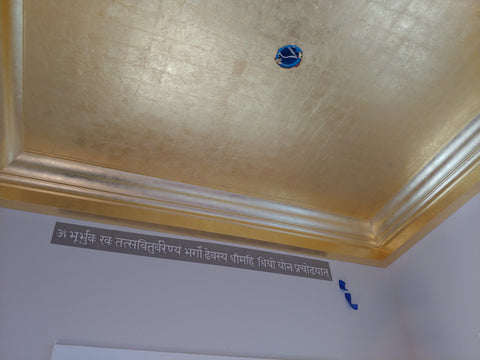October 06, 2019

How to do Gold Leafing, its history and techniques:
Every dark cloud has a silver lining- or better yet, leafing

Have you ever found yourself marveling over beautiful gold-adorned mansions in Los Angeles? Or maybe you've felt the desire to have a beautifully decorated house like those in Beverly hills? It would certainly be a dream come true. Yearn no more, because a marvelous interior could be the highlight of your very own house by using simple techniques that could be easily learned online. Accessories with golden, silver or copper embellishments, to intricate furniture designing, can easily be done at home by your own hands. With a little bit of practice, you can make your house look stunningly beautiful. All you need to learn is the art of gliding with easily accessible gold, silver, or copper leaf paper.
It’s as easy as we’re making it sound like
It is an easy approach to interior design. Gold, silver, or copper leaf is basically a metal hammered until it’s as thin as paper. It’s a much more affordable option to get a shiny touch to your house, rather than using solid gold. Any surface may be coated to give a dazzling new look to it. This includes window frames, shelves, pottery, or any other accessory that adds to the beauty of your vicinity.
The old, golden days
It’s a technique that has been practiced since 400 AD when gold became an item of popular use in Byzantine and Roman churches. The walls of these churches were coated with gold leaf, giving them a royal look. These ancient buildings add scenic beauty to their respective countries and attract flocks of tourists from all over the world. Gold leaf was highly regarded for its ethereal aesthetic. It was used to decorate statues of gods, precious amulets, and other holy objects placed in pharaoh’s tombs in Egypt. Roman medallions and pendants were rendered in gold leaf. Japanese artists integrated gold leaf into their paintings in the 16th and 17th centuries. Even today, designers continue to use the medium in a diverse range of artwork.
Let us get started.
As mentioned before, leafing is an easy process. There is no rocket science involved. Do you recall doing paper collage back in kindergarten? It’s pretty much the same thing, just a hundred times more beautiful.
All you need is:
A vast variety of karats and shades of Gold leaf are available at stationery shops. The most commonly used gold is 22-karat yellow gold. However, metal leaf can also be used. These are thin sheets of metal of any color that does not contain any real gold. Other alternatives are silver leaf, bronze leaf, and copper leaf. Whatever you go for depends on the aesthetic you are trying to achieve. It will be the epitome of beauty, nonetheless.
Any soft, flat brush may be used. Any type of strong colorless adhesive may be used for gluing the gold leaf to a flat, even surface seamlessly. A standard spray adhesive, Spray adhesive is a bit messy and more difficult to control, but also gives a nice finish. Water-based adhesives give the best results.
In the end, comes a gliding brush and setting spray. These are both readily available in art stores in most places as well as stores online. Blick, Jerry's Artarama, North Light Shop, Plaza Artist Materials, and Amazon are some of the most reputable art stores where high-quality brushes are available. A side note, however: a simple flat brush gives a pretty effect if used correctly. When it comes to setting spray, a basic level lacquer spray is fit to seal the glow.
It's much easier than digging up gold
The procedure is quite simple. It’s an enjoyable and soothing experience. You might fall in love with the catharsis, even.
Why use gliding?
Gliding is an excellent choice when it comes to personalizing your house. After all, any sort of metal leaf may be used, shimmering gold, radiant silver, grand bronze, or cozy copper. Accessories such as lamplights or flower pots may be glided to match the furniture- or add a little contrast. This way or the other, leafing may be the reason why your friends and family might walk into your house with awe.
It’s approved by those up in the Hills
Gold leafing is trending as well. Many huge companies specializing in ‘specialty finishes’ are offering custom-designed gliding in Los Angeles. They specifically target the gaudiest of mansions to showcase perfection in gold, silver, or copper leafing, gaining tons of buyers worldwide. California Wall Design is one of the major companies servicing gold leafing in Beverly hills, claiming that their work has turned houses into some of the most beautiful ones out there.
We bet that you will never regret
Gold and silver leafing is definitely a sensible, cost-efficient choice both for the rich out in the Hills or commoners down the street. It is an easy DIY, and it looks magnificent as well. Interior design is not something that can only be perfected through years of study. Simple tricks to decorate your house can elevate its atmosphere and make your life beautiful and worthwhile.
